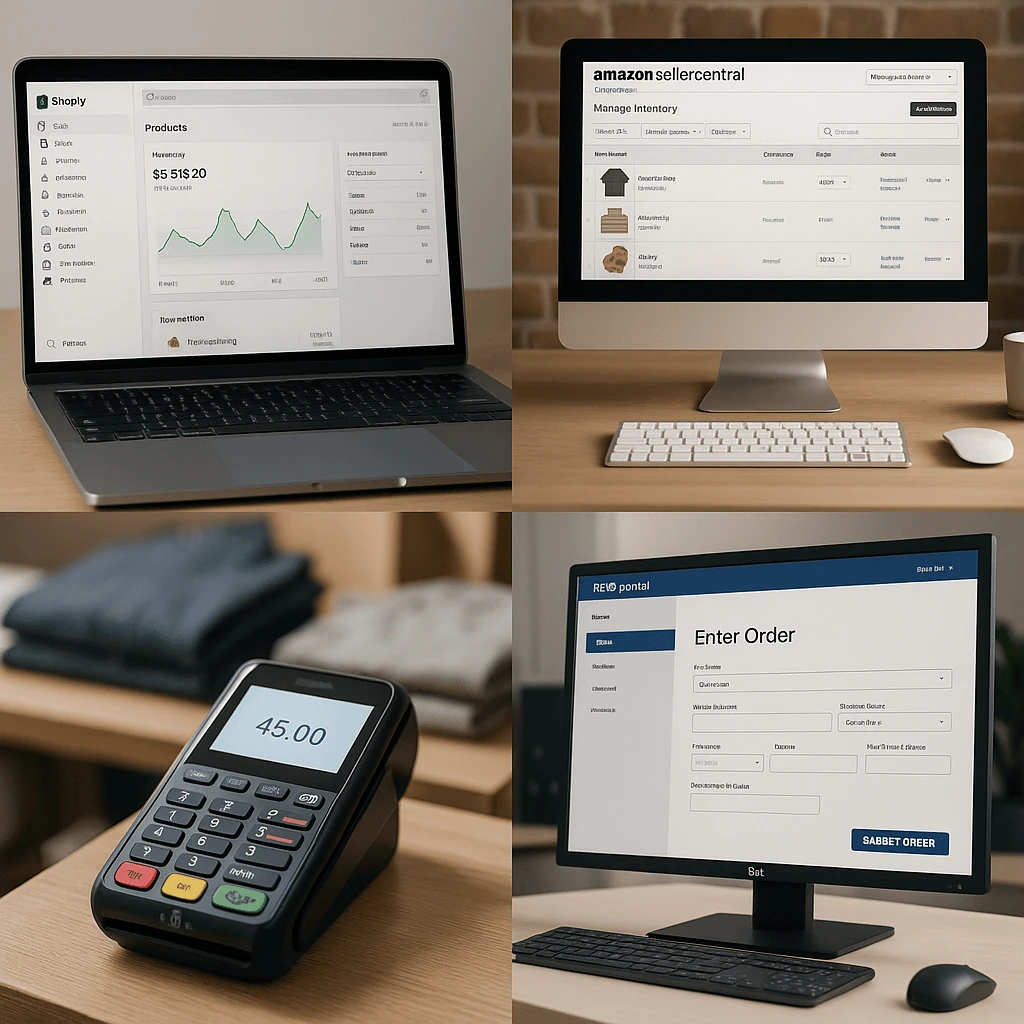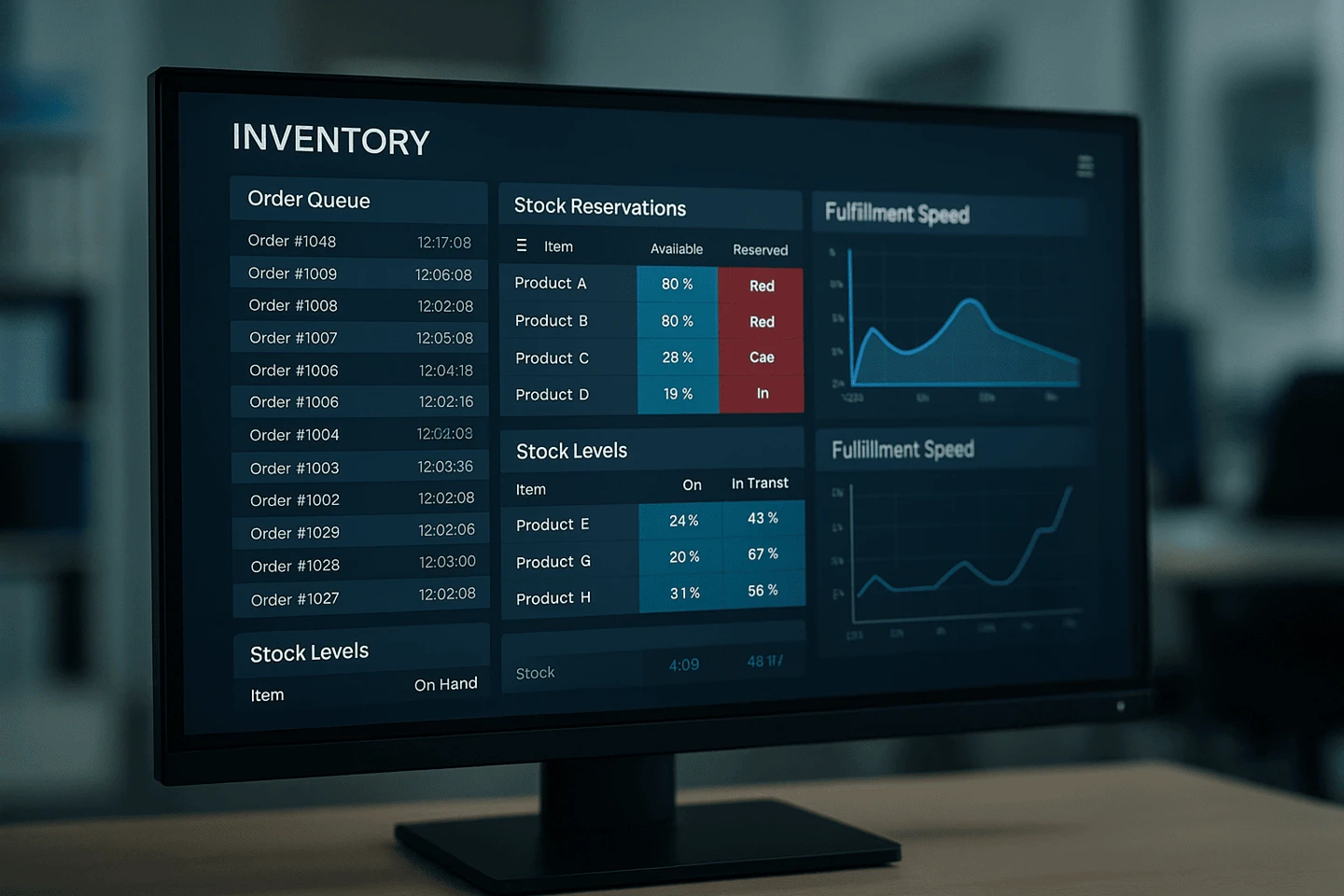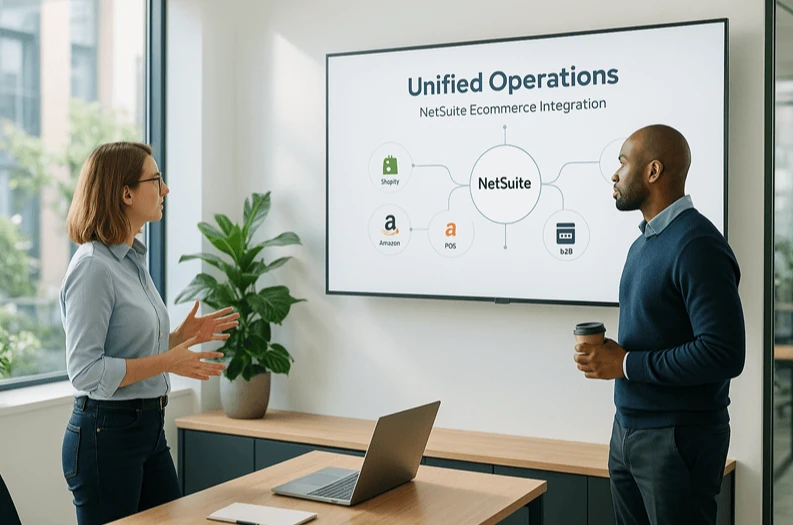NetSuite Shopify Connector: Multi Channel Sync Across Shopify, Amazon, and POS
Multi-channel chaos ends when your systems speak the same language. A well-designed NetSuite ecommerce integration keeps Shopify, Amazon, POS, and B2B channels aligned under one inventory truth. It prevents overselling, simplifies fulfilment, strengthens financial accuracy, and restores team confidence, turning integration from a technical headache into the foundation of scalable growth.
Who this is for
This guide is for you if any of these sound familiar:
- You sell on two or more channels and reconcile inventory manually.
- You've oversold during a sale event and paid for it in credits or reputation.
- Your finance team spends weekends reconciling settlement reports.
- Launching a new channel takes months, not weeks.
If so, this article will help you turn complexity into control with a reliable NetSuite ecommerce integration.
When your inventory system lies to four systems simultaneously
Tuesday morning. Your warehouse manager calls: "We're showing negative inventory for the best-selling SKU." Your Shopify store says 23 units are available. Amazon shows 31. Square POS shows 18. Your B2B portal shows 40.

NetSuite, your supposed source of truth, shows 12 physical units. The math doesn't work because each channel is operating on different sync cycles, different reservation windows, and different allocation logic. By the time you manually reconcile across all four systems, you've burned two hours and discovered six orders that shouldn't have been confirmed.
The technical term is "split-brain syndrome." The actual term is "Tuesday morning fire drill." This guide shows how to architect NetSuite ecommerce integration so your inventory master actually masters inventory.
Why most NetSuite ecommerce integrations break under pressure
Most retailers bolt each channel to NetSuite with one-off connectors that poll on their own cadence. During peaks, those batch windows create "split-brain" inventory: one channel reserves units while another (still on a stale snapshot) sells from the same pool. The remedy starts with event-driven updates from NetSuite (SuiteScript user-event/webhook style) so downstream systems see changes as they happen, not 15 minutes later.
The stakes are enormous. According to IHL Group's 2023 retail inventory distortion study, global inventory distortion totalled $1.77 trillion, with out-of-stocks accounting for $1.2 trillion and overstocks totalling $562 billion, a figure exceeding the entire retail GDP of Latin America.
Even small synchronisation gaps translate into substantial financial losses across channels. The report found that empty shelves remain the largest component of inventory distortion at $707.4 billion in costs, often exacerbated by the lack of real-time visibility across sales channels.
The most critical step in reducing inventory distortion is achieving accurate data and a single version of the truth: a unified, enterprise-wide view of all inventories, fed from multiple sources. Without real-time synchronisation, retailers can experience inventory count discrepancies of over 25% between what their systems report and actual stock levels.
The IHL study notes that technologies like RFID and inventory visibility software can improve store-level inventory accuracy to 95% or higher, but only when paired with an event-driven architecture that eliminates batch-processing delays and ensures all channels operate from the same real-time data foundation.
The hub-and-spoke architecture that works
Point-to-point creates exponential complexity: five channels means ten fragile integrations. In a hub-and-spoke model, a central orchestration layer sits at the centre. NetSuite, Shopify, Amazon, Square, and portals connect as interchangeable spokes, with the orchestrator handling translation, timing, and event-driven updates.
This delivers:
- One inventory truth – the orchestrator aggregates physical, allocated, and available-to-promise stock from NetSuite or any ERP.
- Real-time reservation – the moment Shopify receives an order, the orchestrator coordinates the reservation before confirmation.
- Intelligent routing – orders ship from optimal warehouses based on distance, cost, or capacity.
- Unified customer view – one contact record regardless of channel.
- Consolidated financials – consistent GL codes across every sale.

This mirrors Gartner's composable enterprise philosophy as outlined in Capgemini’s Composable Commerce paper: modular, API-first components orchestrated centrally, where any spoke can be swapped without rebuilding the entire system. This orchestration layer (managing event streams, data translation, and cross-system coordination) is precisely Exsited's domain.
For a deeper look at how architecture decisions vary across connectors, APIs, and operations platforms, see Shopify NetSuite Integration: The Complete 2026 Guide.
Channel-specific integration realities
Shopify: Flexibility creates complexity
Shopify's variant system rarely matches NetSuite's item matrix. Configure it wrong and you'll rebuild your catalogue later. Bundles complicate costing; decide whether they're assemblies, kits, or BOMs. International stores require foreign-exchange accuracy down to rounding decimals. And Shopify customers expect tracking within hours, not days, so the integration must juggle partial fulfilments and backorders seamlessly.
Amazon: Where simple assumptions go to die
FBA and FBM behave like separate worlds. Track FBA inventory separately, or you'll double-sell. ASIN mapping shifts constantly; a single ASIN can cover multiple SKUs. Settlement reports land every 14 days with hundreds of line items that must reconcile in NetSuite or finance will spend weekends chasing gaps. During events like Prime Day, rate-limit management determines whether you keep selling or crash. (Think of Amazon APIs as caffeinated interns: great when focused, chaotic when overloaded.)

Square POS: Real-time meets real-world
In-store shoppers expect instant answers. Your POS-NetSuite link must respond in milliseconds. Offline mode keeps tills alive when networks drop, so queued transactions must sync later without duplication. Even minor naming mismatches, such as "Store_3” vs "Store03”, can break location reconciliation.
B2B portals — business logic gravity
Contract pricing, quote-to-order approvals, and credit-limit checks all depend on NetSuite data. Portals need live pricing APIs and order holds when customers exceed their credit limit. Minimum-order and case-pack rules add freight complexity that consumer channels never face.
Inventory reservation: The make-or-break detail
Overselling happens between order placement and inventory allocation. The integration must reserve stock in NetSuite before confirming the sale.
Best practice:
- Immediate reservation at order submit.
- Time-bound holds for unpaid carts.
- Multi-location logic to split or re-route orders.
- Clear backorder rules by channel.

Common failures: race conditions when two channels grab the last unit, sync delays from 15-minute polling, or mismatched warehouse codes. Businesses that treat reservations as mission-critical avoid 90% of oversell incidents. Everyone else keeps discovering new ways to apologise for 'technical glitches'.
Reservation timing by business type:
| Business Type | Reservation Timing | Why |
| High-volume D2C | Immediate | Prevent overselling during flash sales |
| B2B, quote-based | On approval | No need to block stock pre-commitment |
| Dropship-heavy | Post-payment | Stock not owned until paid |
Fulfilment routing & returns
Smart routing balances speed, cost, and capacity. Ship from the nearest or least-busy warehouse; reserve FBA orders for FBA locations. But the smartest systems don't just pick by distance, they pick by economics. A closer warehouse may be overloaded, while a regional hub with lower labour costs and faster pick/pack may deliver better margins overall. A well-designed NetSuite ecommerce integration uses data to optimise these decisions.
Returns require the same precision. Shopify returns trigger exchanges; Amazon differentiates between sellable and damaged stock; POS returns must link back to online orders. B2B warranty returns feed different GL accounts than retail refunds. The integration must understand every rule.
Finance & tax reconciliation
Each channel handles money differently:
- Shopify Payments deposits net of fees; NetSuite must separate revenue and expense.
- Amazon settlements bundle sales, fees, and refunds every 14 days.
- Square adds software and hardware charges to monthly statements.
- B2B terms introduce ageing, dunning, and AR tracking.
Multi-channel selling also creates multi-jurisdiction tax obligations. FBA inventory establishes nexus in additional states; retail outlets add more. Proper NetSuite ecommerce integration tags transactions with tax codes, exemption certificates, and addresses so audits end quickly.
Implementation Roadmap (3–5 months realistic)
A well-planned NetSuite ecommerce integration typically unfolds in four phases:
Phase 1 – Foundation (Weeks 1–3)
Configure NetSuite locations, price levels, and GL mappings. Clean data, merge duplicate SKUs and customers, verify stock counts, and design monitoring dashboards.
Phase 2 – Primary Channel (Weeks 4–7)
Start with the largest channel (usually Shopify or Amazon). Map items, test 100 historical orders, run in parallel for 2 weeks.
Phase 3 – Add Channels (Weeks 8–14)
Integrate one at a time. Validate FBA, offline POS recovery, and B2B credit workflows. Stress-test at 10× load.
Phase 4 – Cutover & Stabilisation (Weeks 15–20)
Go live midweek, monitor 24 hours, and reconcile daily. Fine-tune routing and reservation thresholds from live data a day. Sequential rollouts uncover one-third as many issues as all-at-once launches. The moral: slow is smooth, smooth is fast.
Monitoring & predictive operations
Every NetSuite ecommerce integration eventually faces an API change or rate-limit issue. Continuous monitoring prevents disaster. Even perfect integrations have bad hair days.
The best ones, however, warn before they break. Predictive monitoring uses historical sync data to flag anomalies: an unusual spike in retry attempts hints at rate-limit pressure; a delayed settlement report foreshadows API updates; repeated lag across stores might indicate local network issues.

Watch daily:
- Sync health dashboards (failed transactions, rate limits).
- Reconciliation reports (orders, inventory, settlements, tax).
- Exception queues (manual approvals, payment retries).
When issues hit: use predefined severity levels, escalation paths, and fallback SOPs. Post-incident, log root cause, business impact, and fix. A distributor that lost Amazon API connectivity for four hours avoided customer impact entirely thanks to alerting and a manual order queue.
Executive Takeaway: Proactive monitoring isn't overhead, it's reputation insurance. The faster you detect failure, the less your customers ever notice it happened.
For compliance-grade monitoring and audit requirements, explore Shopify Plus ERP Integration: Enterprise Implementation Playbook.
Total cost of ownership (24-month outlook)
Before choosing a platform, it's worth defining what sits between the extremes of DIY scripts and full operations platforms. iPaaS (Integration Platform as a Service) tools like Celigo or Boomi provide a middle ground. They're powerful for teams with in-house technical skills, offering drag-and-drop workflows and API flexibility, but they can become costly to maintain as channel counts and data volumes grow.
Operations Platform
| Cost Factor | Point Solutions | iPaaS | |
| Initial Setup | $15–25 k | $40–60 k | $25–40 k |
| Monthly Fees | $2–4 k / channel | $3–6 k | $4–8 k |
| Maintenance | $30 k / yr | Included | Included |
| Manual Reconciliation | $40 k / yr | $10 k / yr | $5 k / yr |
| Exception Handling | $60 k / yr | $15 k / yr | $8 k / yr |
24-month total: Point $323–381 k | iPaaS $186–302 k | Ops $123–210 k.
Hidden costs include channel-launch delays ($600–800 k in lost revenue) and overselling events ($4–8 k each). A well-managed NetSuite ecommerce integration delivers 12-month payback and approximately 69 % ROI.
For platform-specific pricing and evaluation details, visit NetSuite Shopify Integration Software: How to Evaluate Vendors (2026).
Common Questions
Can I integrate channels incrementally?
Yes, start with the largest channel, stabilise, then add others.
What about channel-exclusive stock?
Use NetSuite location records or allocation rules to reserve inventory per channel.
How do outages affect orders?
Queued transactions retry automatically; alerts notify staff for manual fallback.
Separate subsidiaries per channel?
Not unless legal entities differ; GL segmentation usually suffices.
Sync frequency?
Real-time reservations, 5–15 minute availability updates, and hourly reconciliation.
Where to next
Beyond two channels, complexity scales exponentially. If you're juggling spreadsheets and hoping the numbers reconcile, it's time for a unified infrastructure.
If you're starting with Shopify, read Shopify NetSuite Integration: The Complete 2026 Guide.
If you're evaluating platforms, explore the NetSuite Shopify Integration Software: How to Evaluate Vendors (2026) guide.
If you're enterprise-scale, the Enterprise Implementation Playbook maps your rollout.
If you're managing multiple channels and want a single operational backbone, book a workflow review to see how a unified NetSuite ecommerce integration could work in practice.
References
IHL Group. (2023). Retail Inventory Distortion: The Good, the Bad, the Ugly. Franklin, TN: IHL Group.
Capgemini, "Composable Commerce: Modernising Your Architecture" (2023), pp. 2-3









